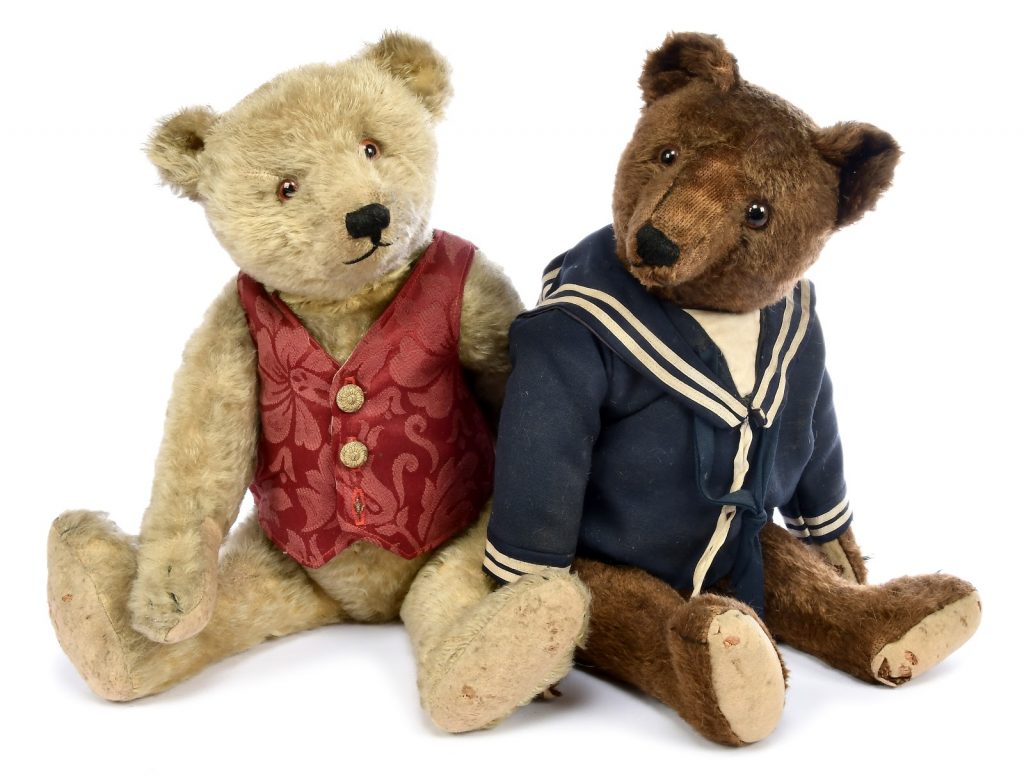Vectis Auctions Keeps Holiday Cheer Coming With January Doll and Teddy Bear Sale

Did Santa deliver your wish list collectible doll, Teddy bear, or plaything this year? If not, here’s another opportunity to add a vintage toy – or two – to your collection! Vectis Auctions, of Thornaby, UK, is holding their annual 500+ lot Doll and Teddy Bear sale on January 14th, 2021. We spoke with Joanne McDonald from Vectis Auctions to learn more about this event and the history behind some of its most eye-catching lots.
Auction Daily: Vectis Auctions traditionally holds a doll and Teddy bear auction in January. Tell us about the history of this signature event and some notable sales from previous years.
Joanne McDonald: After the buzz and excitement of the Christmas period, for some, January can feel long and gloomy. Not for me! Vectis holds between 6 and 8 toy and collectable auctions every month; January is no exception. Posted online before Christmas, it provides many with a welcome break from the mayhem of Christmas, a couple of hours browsing the catalogue, what a delight. With a passion for bears, the New Year Teddy Bear & Doll Auction never fails to fill me with joy and hope whilst providing something to spend my Christmas money on!
Our January sale in 2019 was close to my heart and included some special items from a very special lady, Joan Donachie. I knew her, so it was very poignant to sell her collection. One of the highlights from that sale was a 1930 Steiff Jocko monkey who retained his button in ear ID. He was created in a ginger-colored mohair, rather than Steiff’s standard brown mohair, making him highly desirable. He went on to achieve GBP 3480. Another rarity from this collection was a Steiff somersault elephant from 1909-1910. Her IDs included her button and traces of her earliest white paper ear tag. The elephant is the rarest of all Steiff tumbling animals, only appearing in the catalogue for two years. This might explain why she traded hands at £2040.

AD: This sale features a nice collection of miniature bears, including a number of Schuco cubs and novelties. Tell us about these metal-bodied bears.
McDonald: Schuco novelties appeal to Teddy bear collectors, miniaturists, and novelties collectors, so it is no surprise prices for them remain keen. The German company, Schuco (Scheyer & Co), started making toys around 1912. They produced a plethora of mohair bears in vibrant hues, including purple, yellow, red, and blue, among others. Many of these treasures were miniatures and included hidden secrets in their torsos such as powder compacts, scent bottles (like lot #239), lipsticks, sewing kits, or even playing cards and dice! No fashionable lady from the 1920s would be seen without a novelty piece in her handbag.

In terms of manufacturing, Schuco developed a method of punching a design in flat metal, which was then shaped and covered with mohair. This was pretty ingenious, especially given most bears or animals produced were less than 5″ tall. Schuco novelties that generate the best prices today include those made from rare, vibrant colours, such as cerise pink or bright green, and those produced as bicycle mascots or lamps.
AD: Also on offer are three charming Farnell mascot novelties. What are “mascots” and why are they of interest to collectors?
McDonald: Mascots are sometimes referred to as “soldier bears,” a nickname given to miniature Teddies and animals that brought comfort to so many. The popularity for these items was at its highest during WWI when soldiers were separated from loved ones for long periods. Keepsakes – such as brooches, silks (embroidered postcards), tiny bears, and animals – were presented as love tokens by sweethearts or family members to those away fighting, to remind them of home, to protect them, and to ensure a safe return. These diminutive mascots were produced in large numbers in a variety of colours, the most common being gold but also in patriotic red, white and blue, purple, and green.
Although soldier bears and animals are often attributed to the British teddy bear manufacturer Farnell, it is possible that other British firms also produced them. Farnell mascots are quite distinctive. Fashioned in mohair, the majority measure between 3 – 3.5” tall, lack distinguishable paw or foot pads, are jointed, and have round heads with clear or painted glass eyes or black bead eyes and chenille pipe cleaner ears. The ears are often worn or, lost but the example in the January sale (lot #211) retains these distinctive chenille features. As many were secretly hidden by soldiers (a uniform infringement would be harshly punished), or kept in purses by sweethearts, mascots today are often worn and in need of repair. To find them in such superb condition with IDs – like lot numbers #209, #210, and #211 in our January sale – is exceedingly rare.

AD: Give us the scoop on two of the top Teds in the sale, the Gebruder Bing “Bing Brothers” Teddy bears, lots #225 and #226.
McDonald: In the world of teddy bears, Steiff is recognized today as the dominant force. Prior to 1910, it was another German toy producer, Gebruder Bing, who was hailed as the largest toymaker in the world. At its height, it employed 5,000+ workers and had a factory far exceeding the size and capabilities of Steiff. Gebruder Bing was innovative in design, production, and manufacturing and took excellent care of its workforce, whom it saw as its best asset.
The company, which produced toys of all sorts, was founded in 1865 in Nuremberg, Germany, by two brothers, Ignaz and Adolf Bing. Gebruder translates to “brother” in German, which helps to explain the company’s name. By the mid-1930s, due in part to the German political and economic situation, the company closed its factory and sold its tooling, designs, and materials to the highest bidder.
Bing had always identified its products with embossing, printing, or stamping the words “Bing” or “GBW” onto the metal or wood. Plush proved more difficult to brand, so initially a metal arrow with “Bavaria GBN” or just “GBN” was pinned to the ears of animals.

The magnificent “Bing Brothers” in our January sale have not retained their metal tags but are prime examples of Bing design. Their almost lupine expression commands your attention, something that I find is typical to Bings. Lot #226, the largest bear in blond mohair, has elongated, vertical middle stitching on his nose embroidery, a Bing characteristic.
Alongside him, lot #225, his brother, is in striking chocolate mohair, also with long arms, a lengthened muzzle, hump, with such quality you can see why these beautiful examples are often mistaken for Steiff. One of the differences is the finishing seam to the front torso on Bing bears, which both of these bruins have. They, alongside over 100 other bears, have come from a single owner who purchased many of them at London auction houses and antique fairs during the 1980s and 1990s.
AD: And finally, Teddy collector yourself, which of the lots call to you?
McDonald: In addition to researching, collecting, cataloging, making, and generally eating, sleeping, and dreaming teddys, I manage to squeeze in a passion for dogs. I have two black labradors. Lot #209, the Farnell “Alpha Toys” vintage miniature rare mascot dog with its original card label, is barking for my attention. Growing up with a Jack Russell terrier who was extremely naughty, this chap has the same ready-for-anything attitude. A close second would be lot #212, the Deans ‘Pompey’ dog, for similar reasons, but I am also attracted by provenance and mystery. This canine companion was produced by Deans for the British newspaper the ‘Daily Sketch’ in the 1920s and 1930s, although I have yet to find any printed cartoons or adverts for ‘Pompey.’ If anyone reading this has come across any, please let me know!
For more information on Vectis Auctions’ January 14, 2021 Doll and Teddy Bear Sale, please see their website.
Want to read more interviews with category experts? Auction Daily sat down with the President of the New England Steiners, Stuart Weiss, Sr., to discuss beer stein collecting.










